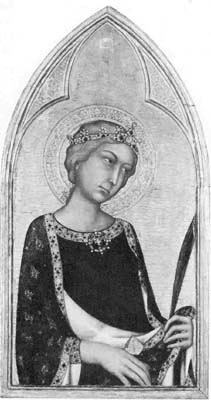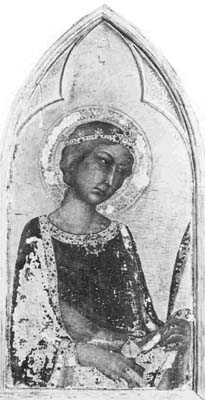
Annual Bulletin 3, 1979-1980
Home
Français
Introduction
History
Annual Index
Author &
Subject
Credits
Contact


Simone Martini's
St Catherine of Alexandria:
An Orvietan
Altarpiece and the
Mystical Theology of St Bonaventure
by Joel Brink
Article en français
Pages 1 | 2
| 3 | 4
| 5 | 6
| 7 | 8
Per mirar Policleto a prova fiso,
con gli altri ch'ebber fama di quell'arte,
mill'anni, non vedrian la minor parte
cella beltà che m'àve il cor conquiso;
ma certo il mio Simon fu in paradiso,
onde questa gentil Donna si parte;
ivi la vide e la ritrasse in carte,
per far fede qua giù del suo bel viso.
L'opra fu ben di quelle che nel cielo
si ponno imaginar, non qui tra noi,
ove le membra fanno a l'alma velo... (1)
When Petrarch wrote these lines about Simone Martini's portrait of Laura, the humanist poet and moral philosopher was in effect promoting the name of the painter and celebrating for future generations of literati the intrinsic qualities of his creations. Equally important are Petrarch's personal praises of the painter inscribed in the margin of his Pliny, or in the illuminated frontispiece that Simone prepared for the poet's copy of Servius's Commentary on Virgil on the eve of the poet's Roman Coronation. In his copy of Pliny, Petrarch compares his painter-friend favorably to Apelles who, according to Pliny, could speak on equal terms with Alexander the Great.
(Hec fuit et Symoni nostro Senensi uper iocundissima). And in the illumination Petrarch eulogizes Virgil and Simone in a rhymed couplet identifying them as individual creative Italian artists spanning the ancient Roman and contemporary worlds:
Mantua Virgilium Qui Talia Carmina Finxit/Sena Tulit Symonem Digito Qui Talia
Pinxit). (2) For Petrarch, the fame of the Sienese artist was based on the enraptured beauty of his creations
- which the humanist poet could perceive and express in verse so well; but
as fate would have it, later biographers, especially the influential Vasari,
attributed Simone's fame to what Petrarch had written rather than to
what the painter had created. Vasari observes that Petrarch 's sonnets
"have given more fame to the poor life of Maestro Simone than all his own
works have ever done or ever will, seeing that they must at some time
perish...." (3)
The portrait of Madonna Laura unfortunately has perished, and we can be thankful for Petrarch's inspired lines which keep its memory alive. But the fame of Simone of Siena still lives on through his many preserved masterpieces, some of which were unknown to Vasari, and others which have come to light only recently. As the seventh centenary of Simone's birth
rapidly approaches, in c. 1984, a number of the painter's outstanding
works are attracting renewed scholarly interest. One such painting, and
indeed one of the truly exquisite examples of Simone's artistic genius,
is found today in the National Gallery of Canada (fig. 1). The crowned
martyr, probably St Catherine of Alexandria, is also worthy of poetic
praise; for, its feminine grace and decorative charm undoubtedly preserve
in material form the same sublime qualities that originally inspired
Petrarch's moving sonnets on the portrait of Laura. The painting is one
of the most cherished treasures in the Ottawa European Collection, and
one of only a few certain works by the great Sienese master in North America.
While known for some time, (4) the painting unfortunately
has not attracted the detailed scholarly attention it deserves, and consequently, important physical,
iconographic and historical evidence relating to its original form, context, and meaning has not
come properly to light. The St Catherine of Alexandria, and the panels to which it was initially attached, formed an innovative painting that reflected the intellectual and spiritual concerns of its patrons. Similar to Simone's other major works of art, the composite painting provides an illuminating document
of the history of ideas during the Italian High Middle Ages.
The National Gallery acquired the painting in 1956 from the
Liechtenstein collection in Vienna. Prior to this time, in the late nineteenth
century, the work had been with the dealer Stefano Bardini in Florence
where it appears to have been restored to its present state. An old photograph
from the Collection of Federico Zeri (fig. 2) illustrates the physical
condition of the painting when it belonged to Bardini, and helps to establish
those parts of the gilded and painted surface renewed at that time. The
halo of the saint, for instance, was severely damaged and much of the gold
leaf was replaced, including the punch-motifs which were modelled successfully
on the extant originals. Besides some minor restoration to the left-hand
arch cusp and to the decorative edge of the outer garment, the rest of
the gold-work - including the background, the jewel-studded crown, the
cross-in-circle broach, and the right-side arch cusp with its distinctive
six-pointed star - are in perfect condition. The pre-restoration photograph
(fig. 2) also illustrates that the mantle which falls over the right arm
of the saint has been almost completely repainted, and that the fingers
of the right hand, the martyr's palm, and portions of the inner garment
have been partially renewed. In contrast, the left hand of the figure
is original and the magnificent head and neck of St Catherine are untouched
by later restoration. Considering the ill effects of cleaning and restoration,
which have ruined other similar panels of the Trecento, the painting in
the National Gallery of Canada survives in excellent condition and remains
one of the representative works of the Master Simone Martini.
Next Page | wooden
superstructure
1 |
2
| 3 | 4
| 5 | 6
| 7 | 8
Annual Index | Author & Subject | Credits | Contact
This digital collection
was produced under contract to Canada's Digital Collections program,
Industry Canada.
"Digital
Collections Program, Copyright
© National Gallery of
Canada 2001"